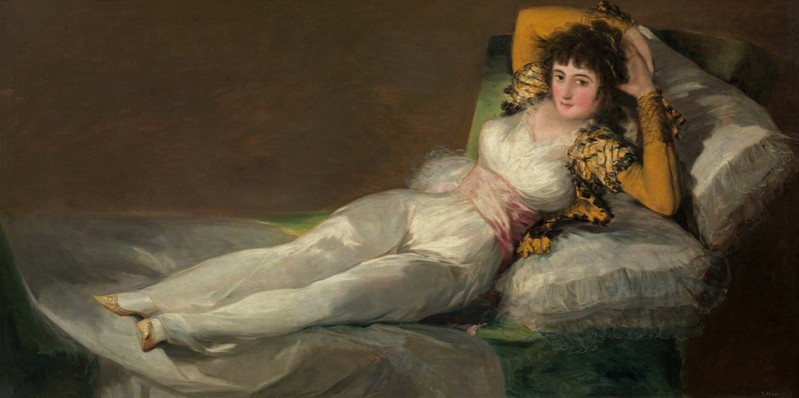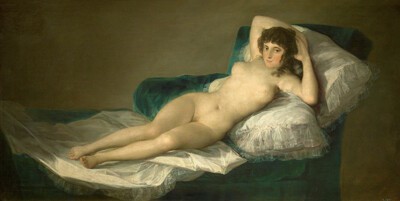- Cronología
- 1800 - 1807
- Ubicación
- The Prado National Museum. Madrid, Madrid, Spain
- Dimensiones
- 95 x 188 cm
- Técnica y soporte
- Oil on canvas
- Reconocimiento de la autoría de Goya
- Documented work
- Titular
- El Prado National Museum
- Ficha: realización/revisión
- 04 Feb 2010 / 15 Jun 2023
- Inventario
- (P00741)
This work formed part of Manuel Godoy's art collection. Following the Aranjuez uprising of 1808 and the abdication of King Charles IV that same year, the work was seized, along with other items, by order of Ferdinand VII. Between 1808 and 1813 it was stored, together with The Nude Maja, at the Royal Academy of Fine Arts of San Fernando and in 1813 it was confiscated by the Inquisition. It was kept at the Madrid academy from 1836 until 1901, when it entered the collection of the Prado Museum, being mentioned in the museum's catalogue for the first time in 1910.
It is thought that this canvas could have been painted several years after its pair, The Nude Maja.
The first mention of this painting dates back to 1808 and the inventory that Fréderic Quilliet, an agent of Joseph Bonaparte, drew up of the estate of Manuel Godoy (Badajoz, 1767-Paris, 1851). In 1813, in the inventory made following the seizure of Godoy's property by Ferdinand VII, the two majas are referred to as "gypsies".
Here we see the figure of the maja reclining on a green divan which is partially covered by a white bedspread and pillows. Her legs are slightly bent and her arms are folded behind her head. She is wearing delicate transparent clothes, tied around her waist by a pink silk sash. On her shoulders she wears a short yellow jacket with black decoration. On her feet is a pair of pointed shoes, the same colour as the jacket. Poking out from underneath the woman's hip we can see a reddish object which some writers have suggested could be the hilt of a dagger, although other scholars believe it to simply be a closed fan.
The artist has made use of a greater degree of artistic freedom in this painting than in the much more academic treatment employed in The Nude Maja. Here, loose brushstrokes and thickly applied paint are used to recreate the maja's clothing. Goya deftly captures the folds in the white fabric covering her body and the shimmering cloth of her pink sash and pointed shoes. More time has been spent on rendering the flesh tones of the face and the dark curly hair.
The woman's posture reveals certain similarities with another female portrait by Goya, that of Joaquina Téllez-Girón y Alfonso Pimentel, Marchioness of Santa Cruz (1805, Prado Museum, Madrid). Both women are shown dressed in the clothing that perhaps best characterized their personalities. In the present work, the woman is dressed as a maja, whilst the Marchioness of Santa Cruz is dressed as Erato, the muse of romantic poetry. Both women are shown in seductive poses and adopting an attitude which challenges the traditional coyness and reserve of female figures. The intelligence and directness of their gaze is also remarkable, revealing the resolute, active personality of these women. In these paintings, Goya demonstrates how a woman's intelligence and attitude can prove to be at least as seductive as her naked form.
-
Goya 1900Ministerio de Instrucción Pública and Bellas ArtesMadrid1900consultant editors Aureliano de Beruete, Alejandro Ferrant, Marqués de Pidal and Ricardo Velázquez. May 1900cat. 8
-
Les chefs-d’œuvre du Musée du PradoMusée d’Art et d’HistoireGeneva1939consultant editors Fernando Álvarez de Sotomayor y Pedro Muguruza Otaño. From June to September 1939cat. 7
-
Goya and his timesThe Royal Academy of ArtsLondon1963cat. 66cat. 86
-
El arte de GoyaMuseo de Arte Occidental de TokioTokyo1971from 16th 1971 to January 23th 1972. Exhibited also at the Kyoto Municipal Museum of Art, January 29th to March 15th 1972.cat. 30
-
GoyaPalacio de PedralbesBarcelona1977from April 12th to June 30th 1977cat. 37
-
De El Greco a GoyaPalacio de Bellas ArtesMexico D.F.1978November-December 1978cat. 36
-
Goya in the Metropolitan Museum of ArtThe Metropolitan Museum of ArtNew York1995consultant editors Colta Ives and Susan Alyson Stein. From September 12th to December 31st 1995cat. 5
-
Realidad e imagen. Goya 1746 – 1828Museo de ZaragozaZaragoza1996consultant editor Federico Torralba Soriano. From October 3th to December 1st 1996cat. 44
-
Goya. 250 AniversarioMuseo Nacional del PradoMadrid1996consultant editor Juan J. Luna. From March 29th to June 2nd 1996cat. 95
-
Goya luces y sombrasCaixaForumBarcelona2012consultant editors José Manuel Matilla and Manuela B. Marqués. From March 16th to June 24th 2012cat. 21
-
GoyaBasle2021p. 241
-
L'œuvre peint de Goya. 4 volsParís1928-1950p. 106, cat. 388
-
Vie et ouvre de Francisco de GoyaParísOffice du livre1970p. 188, cat. 744
-
BarcelonaPolígrafa1970vol. I, p. 339, cat. 539
-
Obras famosas de GoyaNatterman Internacional1970p. 180 y 181 (il.)
-
GoyaBarcelonaCarroggio S.A. de Ediciones1974p. 188, cat. 341
-
Francisco de Goya, 4 vols.ZaragozaCaja de Ahorros de Zaragoza, Aragón y Rioja1980-1982vol. II, p.128 y 130
-
Las majas de GoyaMadridAlianza Editorial1982pp. 45 a 58
-
Goya. 250 AniversarioMadridMuseo del Prado1996pp. 368 y 369, cat. 95
-
Der Künstler als Kuppler: Goyas nackte und bekleidete Maja en Herding, K.: Aufklärung anstelle von Andacht: kulturwissenschaftliche Dimensionen bildender KunstFrankfurtLang1997pp. 27-33
-
Goya. Die Kunst der FreiheitMunichVerlag C. H. Beck2000pp. 69-72, il. 19
-
Los mundos de Goya (1746-1828)BarcelonaLunwerg2008ils. 176, 177, pp. 289-290

